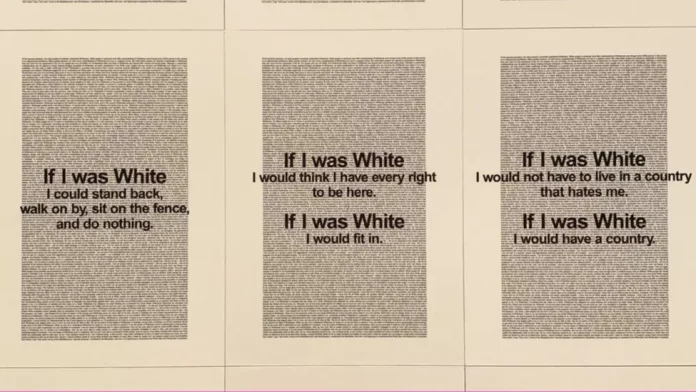At the Auckland Art Gallery this week, artist Vernon Ah Kee unveiled the largest collection of Aboriginal and Torres Strait Islander art ever seen in New Zealand, according to BBC.
The exhibition was dedicated to Resistance and Colonisation. Vernon Ah Kee presented there his 2002 work entitled If I Was White.
If I was White, I could wear a suit and tie and not look suspicious. If I was White, I could shop in luxury stores and not look suspicious. If I was White, I would not have to live in a country that hates me. If I was White, I would have a country.
Some visitors to the New Zealand Exhibition, such as 65-year-old Debbie May, spotted a connection to Australia’s Indigenous referendum called The Voice.
Talk of indigenous rights in New Zealand is increasingly popping up among the population, while neighbouring Australia has launched a landmark vote. If the constitution is updated this Saturday, Aboriginal and Torres Strait Islander people will be recognised as the country’s first inhabitants, which would also allow them to represent indigenous peoples in politics.
However, polls show that the Voice to Parliament proposal will not succeed.
New Zealand is also struggling with a colonial history that has severely disadvantaged its Indigenous population. Like Aboriginal and Torres Strait Islander people in Australia, the Māori are disadvantaged on indicators such as health, household income, educational attainment and imprisonment rates.
Debbie May expressed concern over the likely failure of The Voice, adding:
I think maybe New Zealand is a bit more forward-thinking. Then again, the history of New Zealand and Australia are very different, even though people might see them as similar.
The countries are truly different in many ways. Firstly, Australia is much larger than New Zealand and much more densely populated, with 26 million inhabitants compared to around five million. Of this population, Indigenous Australians make up 3.5 per cent and Māori are a much larger minority of 16.5 per cent.
Māori culture is considered more widely understood than numerous Australian Aboriginal cultures. In particular, the Māori language has been revitalised: locals often refer to New Zealand using its Māori name: Aotearoa.
Meanwhile, there are over 150 different indigenous languages in Australia, of which none have become the mainstream and many are on the verge of extinction.
The countries also differ structurally: Australia is a federation in which many powers, such as policing and health care, are a national responsibility. In contrast, most powers in New Zealand are in the hands of the national government.
Monash University Melbourne historian and New Zealand-based expert on British colonisation, Bain Attwood:
Almost from the outset of colonisation, they went down very different paths.
Māori people have long been represented in the New Zealand Parliament: since 1867, Māori have been given seats in Parliament and electoral districts where only they could run and vote.
And despite the disadvantages, they never lost that political voice. That’s been enormous.
Unlike what happened in Australia, the British Crown considered the indigenous population of New Zealand sovereign and decided to negotiate with Māori leaders.
Australia does not have a treaty with indigenous peoples like the 1840 Treaty of Waitangi in New Zealand: Britain has never recognised Australian Aborigines, nor granted them rights to property, title or land.
According to Australian policy expert Dr Peter Chen of the University of Sydney, the New Zealand treaty “did not solve all the ‘problems’ of the Maori people” but was a tool for organising progress and facilitating some redress of historical grievances.
It’s also been fundamentally something about not just reconciliation and representation, but about reparations.
Polls show that a majority of Australian voters have succumbed to the anti-Vote campaign, which includes misrepresenting it as a third chamber of parliament and claiming it will be able to veto parliament or that white people will lose their lands.”
Australian history taught in schools focuses mainly on the British conquest and the achievements of white settlers, rather than on the impact of colonisation on the indigenous population: massacres, cultural genocide, policies of forced assimilation and integration.
Compared to New Zealand, where settlement was “much more sincere, much more open and organised,” Australia’s history is one of “marginalisation” and “silencing.”
Artist Vernon Ah Kee’s work on the wall also includes the following statement:
If I was White I could stand back, walk on by, sit on the fence, and do nothing.
